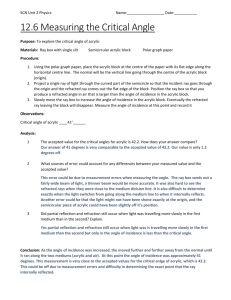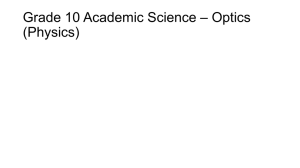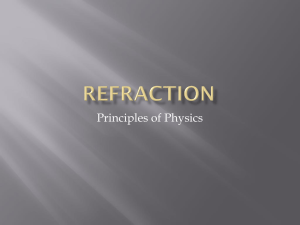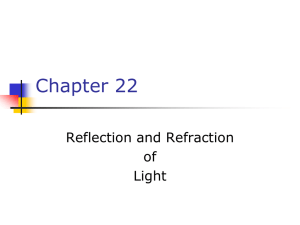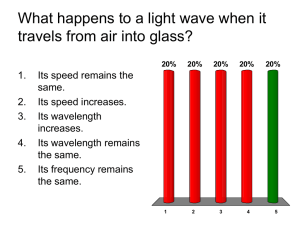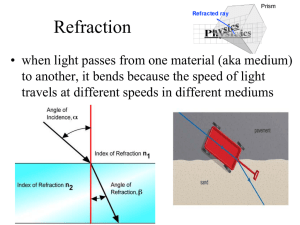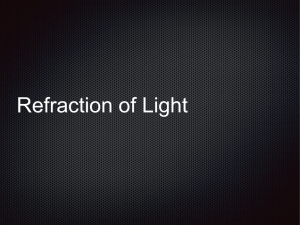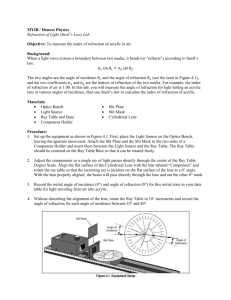Experiment 18
advertisement
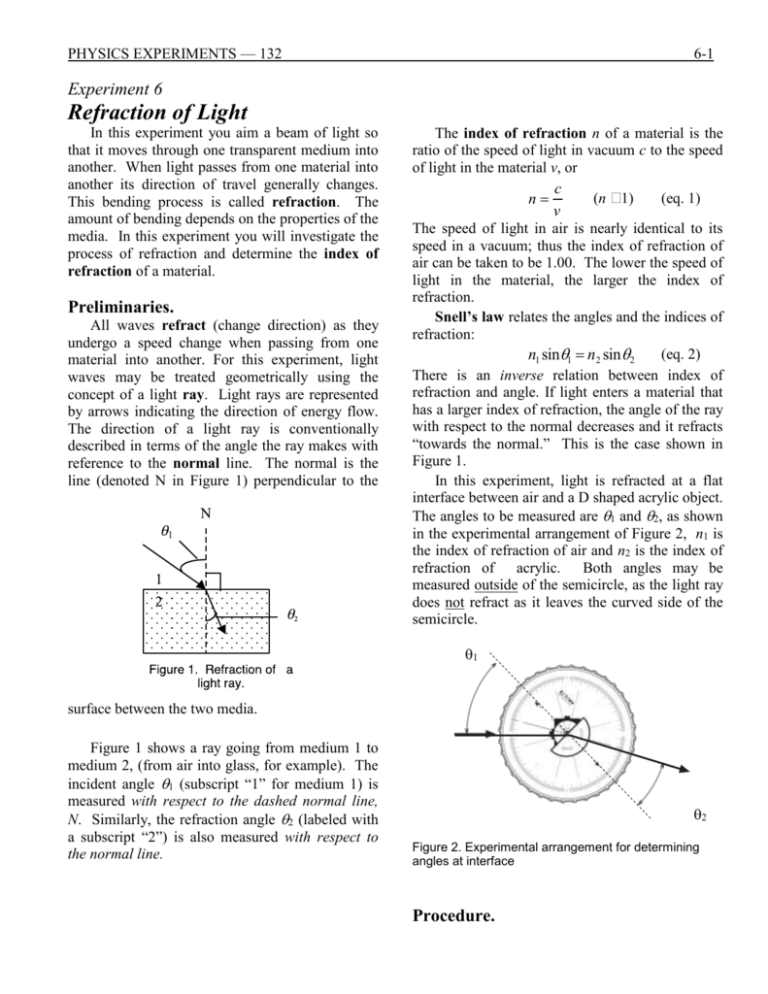
PHYSICS EXPERIMENTS — 132 6-1 Experiment 6 Refraction of Light In this experiment you aim a beam of light so that it moves through one transparent medium into another. When light passes from one material into another its direction of travel generally changes. This bending process is called refraction. The amount of bending depends on the properties of the media. In this experiment you will investigate the process of refraction and determine the index of refraction of a material. Preliminaries. All waves refract (change direction) as they undergo a speed change when passing from one material into another. For this experiment, light waves may be treated geometrically using the concept of a light ray. Light rays are represented by arrows indicating the direction of energy flow. The direction of a light ray is conventionally described in terms of the angle the ray makes with reference to the normal line. The normal is the line (denoted N in Figure 1) perpendicular to the The index of refraction n of a material is the ratio of the speed of light in vacuum c to the speed of light in the material v, or c (n ³ 1) (eq. 1) n= v The speed of light in air is nearly identical to its speed in a vacuum; thus the index of refraction of air can be taken to be 1.00. The lower the speed of light in the material, the larger the index of refraction. Snell’s law relates the angles and the indices of refraction: (eq. 2) n1 sinq1 = n2 sinq2 There is an inverse relation between index of refraction and angle. If light enters a material that has a larger index of refraction, the angle of the ray with respect to the normal decreases and it refracts “towards the normal.” This is the case shown in Figure 1. In this experiment, light is refracted at a flat interface between air and a D shaped acrylic object. The angles to be measured are 1 and 2, as shown in the experimental arrangement of Figure 2, n1 is the index of refraction of air and n2 is the index of refraction of acrylic. Both angles may be measured outside of the semicircle, as the light ray does not refract as it leaves the curved side of the semicircle. 1 surface between the two media. Figure 1 shows a ray going from medium 1 to medium 2, (from air into glass, for example). The incident angle 1 (subscript “1” for medium 1) is measured with respect to the dashed normal line, N. Similarly, the refraction angle 2 (labeled with a subscript “2”) is also measured with respect to the normal line. 2 Figure 2. Experimental arrangement for determining angles at interface Procedure. PHYSICS EXPERIMENTS — 132 6-2 Part I Place the light source in ray-box mode at the end of the optical rail. Turn the wheel to select a single ray. Place the ray table in front of the light source so the ray from the light source crosses the exact center of the ray table. Put the D shaped acrylic on the ray table exactly centered in the marked outline as shown in figure 3. This is your first data point, both angles 1 and 2 are zero. Figure 3. Initial setup Rotate the ray table (as shown in figure 2) to set the angle of incidence, to 10o and record the angle of refraction . Change the angle of incidence by 10o increments up to 80o and record the corresponding angle of refraction for each angle of incidence. Graph the data with the sine of the incident angle on the vertical axis and the sine of the refracted angle on the horizontal axis. Determine the ratio of the indices of refraction n2/n1 from the graph using Snell’s Law. Determine the index of refraction of acrylic assuming that the index of refraction of air is 1.00. Part II In this part of the experiment you will check if the same relationship holds when light is going out of the acrylic into air. Turn the ray table so that the incoming ray enters the D shaped acrylic through the curved surface of the acrylic as shown in figure 4. Figure 4. Experimental arrangement for Part II Set the angle of incidence to 30o and measure the angle of refraction. Note that, in this part the angle of incidence is 2 as the light ray is travelling through medium 2 (with index of refraction n2) when it encounters the flat interface between acrylic and air. Compare your data to the corresponding data point from part I. Is the law of refraction the same for light rays going in either direction between the two media? Using Snell’s law, calculate the index of refraction of acrylic from your measurement. Part III While your experimental set-up is still as shown in figure 4, rotate the ray table to increase the angle of incidence. Keep going until the refracted ray disappears and the light ray is completely reflected back into the acrylic at the interface. This is the critical angle c where you start getting total internal reflection. If the incident angle is greater than the critical angle , there is no refracted ray and total internal reflection occurs. If c, the angle of the refracted ray 2 is 90°. Record the critical angle and use this measurement to calculate the index of refraction of acrylic. Questions (Answer clearly and completely). 1. Why is it important that the incident ray hit the D shaped acrylic at the center? Explain carefully with reference to Snell’s Law. (Note that the ray exiting the acrylic from the curved side does not bend) 2. If the data is plotted with the incident angle on the vertical axis and the refracted angle on the PHYSICS EXPERIMENTS — 132 6-3 horizontal axis, is a straight line expected to result? What is advantage of plotting the data with the sine of the incident angle on the vertical axis and the sine of the refracted angle on the horizontal axis? Explain carefully, with reference to equation 2. 3. What value do you determine experimentally for the index of refraction of acrylic in each part of the experiment? What is the percentage difference between the values obtained in each part? Which result do you think is the most accurate? Explain your reasoning. 4. How did your data in part II compare to the corresponding data point from part I? Is the law of refraction the same for light rays going in either direction between the two media? rev. 10/13


